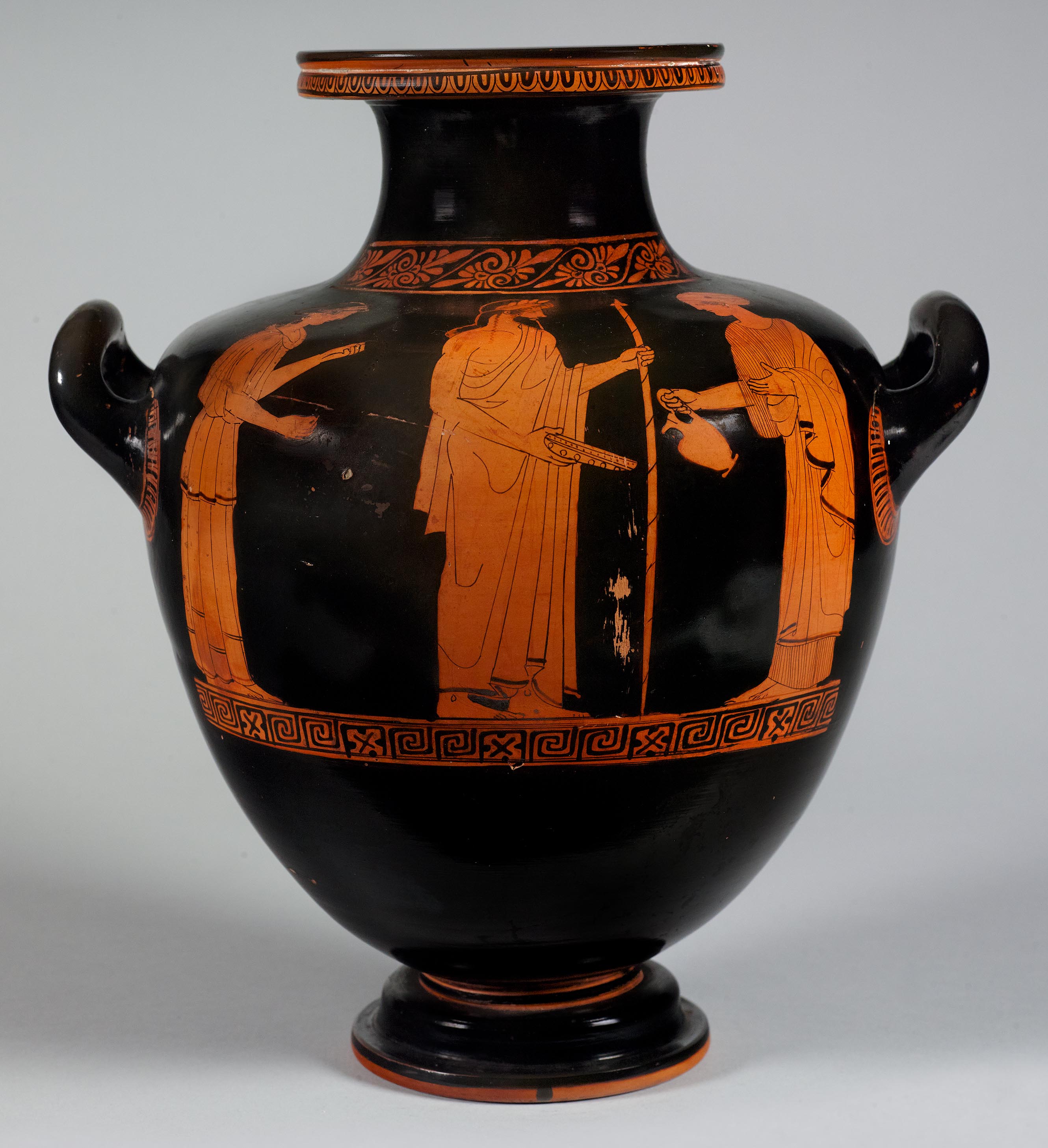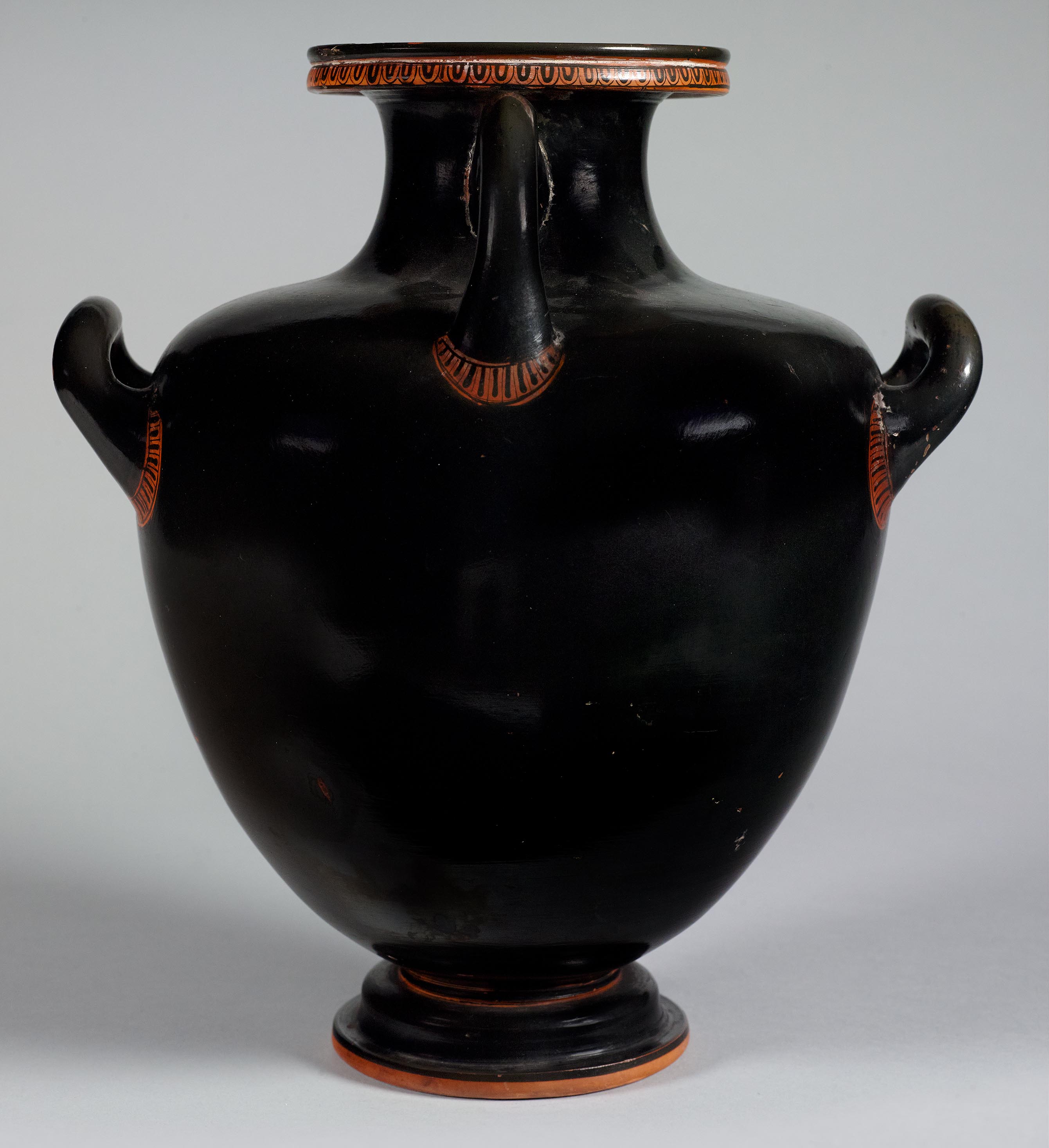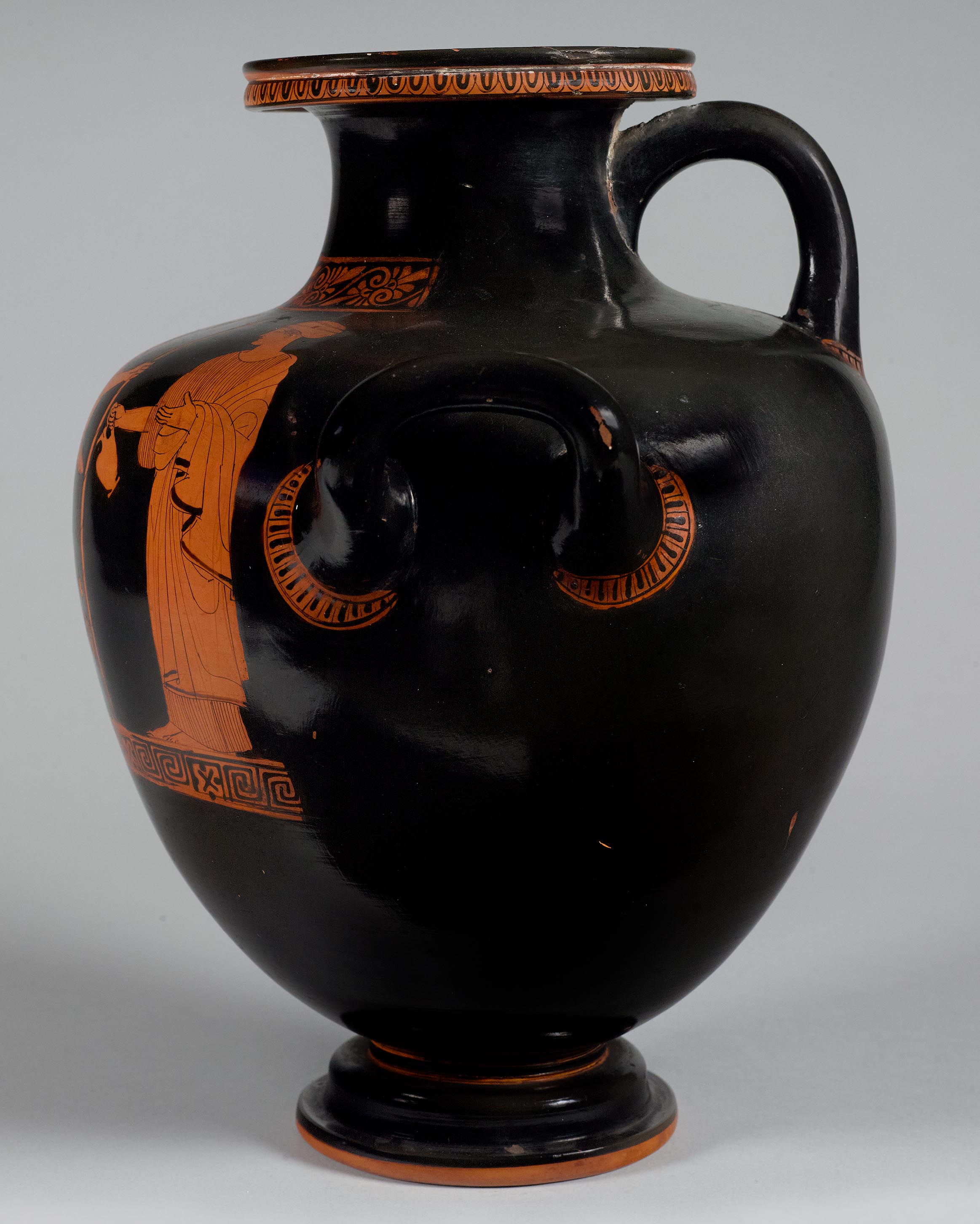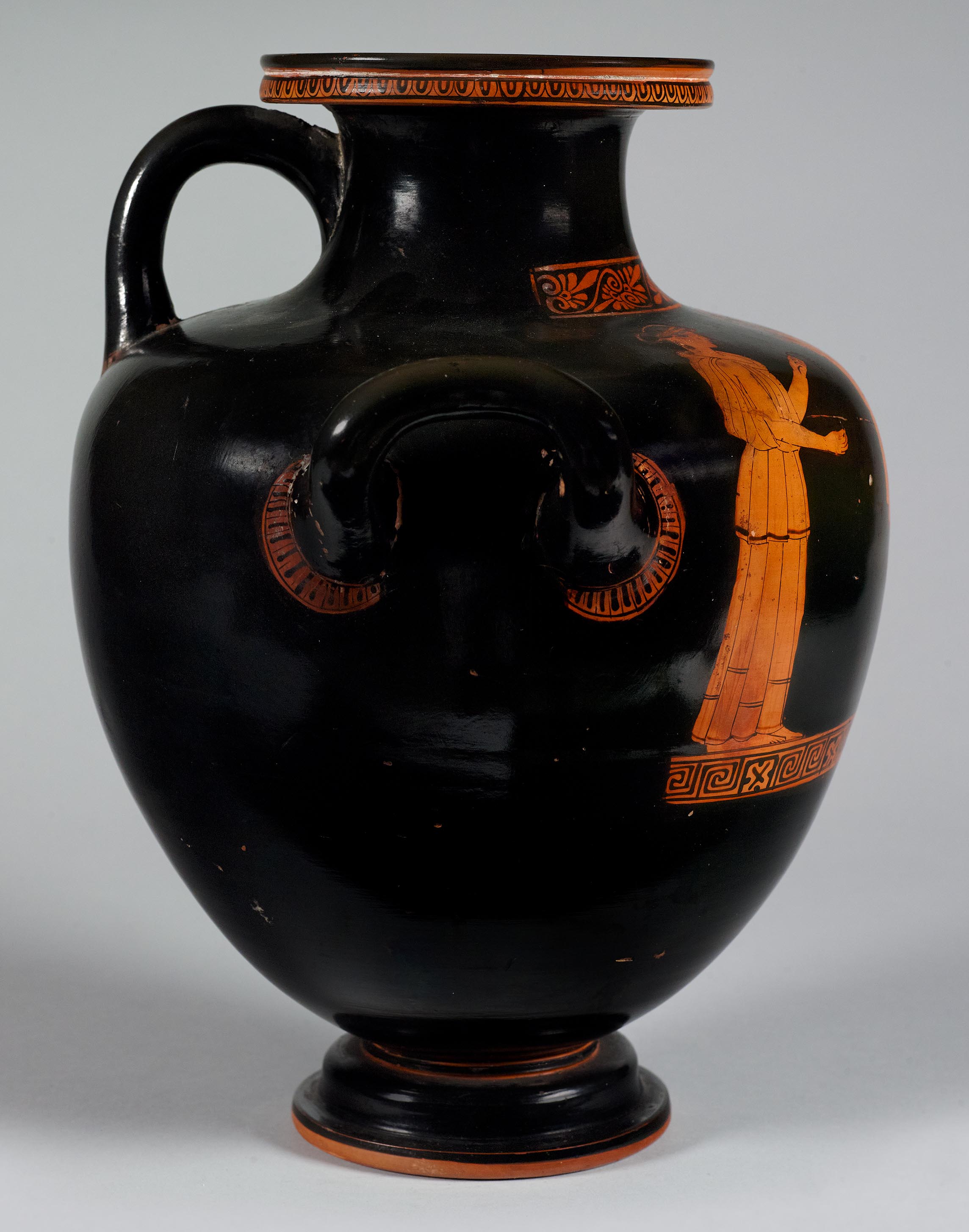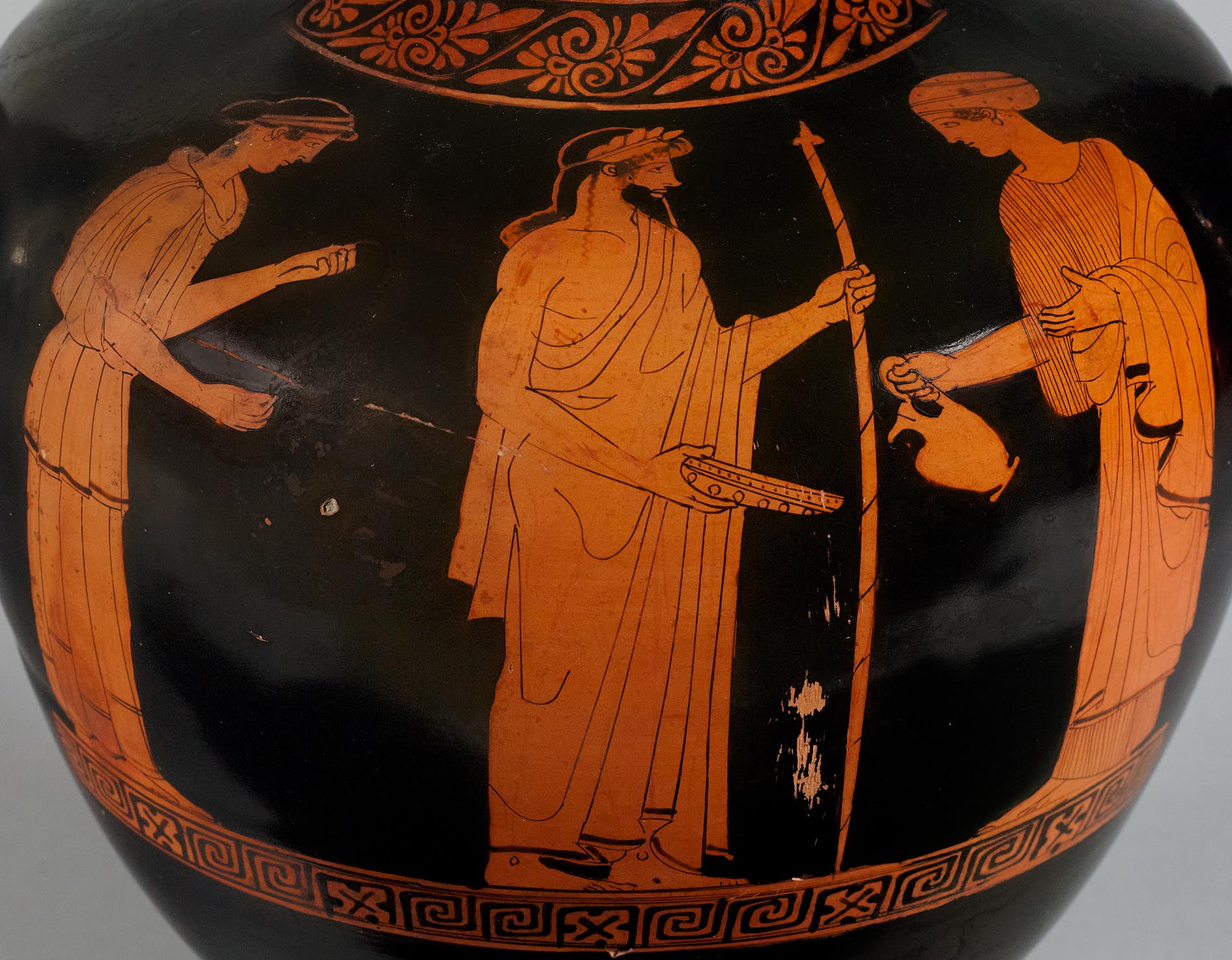Provenance
1899, sale, Thomas B. Clarke Collection, lot 365 (New York, NY) to Junius S. Morgan; 1932, bequest, Junius S. Morgan to Princeton University. Beazley (Abbreviation: ARV2J. D. Beazley. Attic Red-Figure Vase-Painters. 2nd ed. Oxford, 1963 605) stated, without further explanation, that the vase was “from South Italy.”
Shape and Ornament
Rim molded in two degrees: reserved groove between slender, rounded black lip and wider painted ovolo below. Top and underside of rim reserved. Interior of neck black. Continuous profile from neck to foot. Slanted and addorsed red-figure palmettes at base of neck in front. Two black horizontal handles on either side, round in section and curving upward. Black vertical strap handle extending from neck to shoulder. Black tongue pattern partially circles the roots of all three handles. Plump, ovoid body. Groundline of paired, stopt meanders to right, alternating with saltire squares. Ogee foot separated from the body by a fillet framed by two reserved grooves. Underside of the foot reserved, as is the lower half of the lower disk. Circular depression (diam. 3.9 cm) with nipple in center of underside.
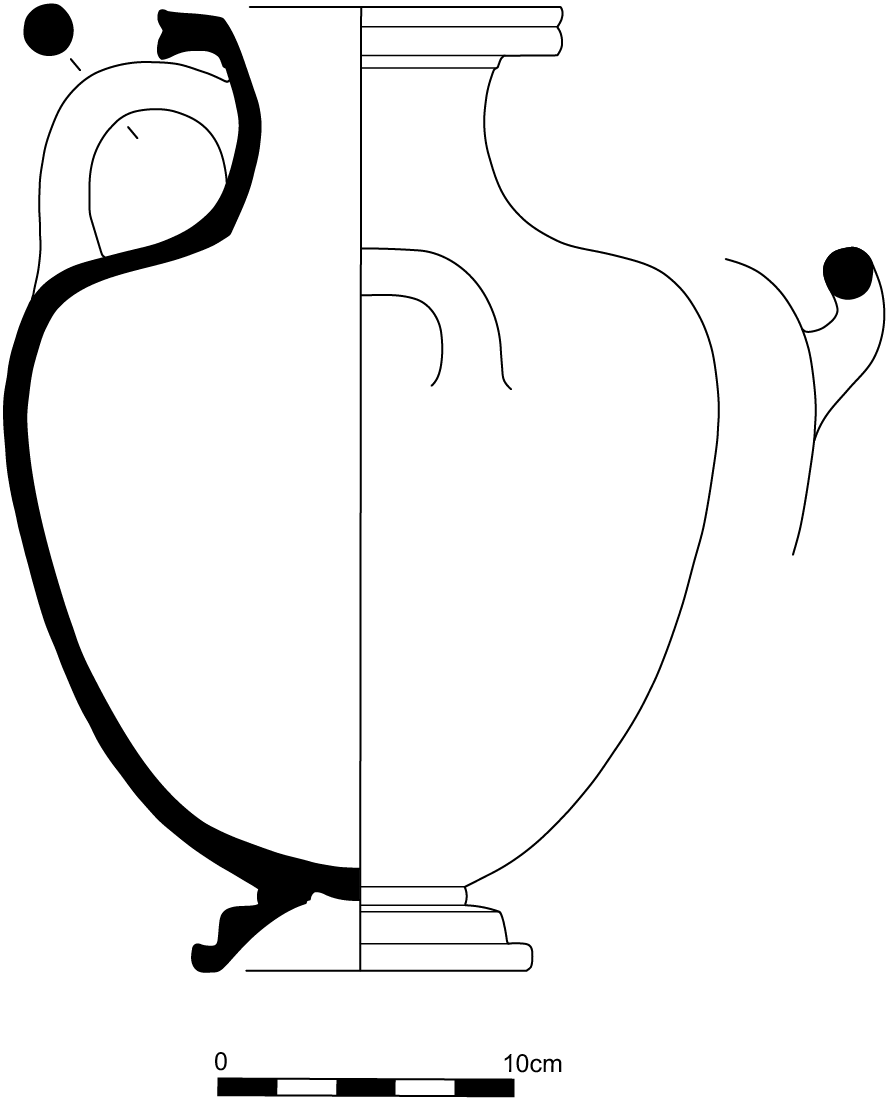
Subject
Libation. At center stands a bearded man with his head in profile to the right, his left foot slightly advanced, and his torso in three-quarter view. He wears a himation with a black border at the hem, and a wreath with reserved leaves. His long hair falls down his back, and a single tress trails over his right clavicle. In his right hand he holds a phiale with a lobed and dotted pattern, and in his left hand a tall scepter, upright and resting on the ground. He tilts the phiale slightly forward, about to pour a libation. Facing him at the right stands a female figure in profile, who holds an oinochoe in her right hand, from which pours a stream of wine in added red, now worn. She gestures toward the man with her left hand. The woman wears a chiton, a black-hemmed himation that wraps around her left arm and shoulder, earrings, and a sakkos with a dotted pattern. To the left of the man stands a second woman in profile to the right, wearing a belted peplos with a black hem, earrings, and a doubly wrapped fillet in her hair. With both hands she holds a wreath in added white, now worn.
Attribution and Date
Attributed to the Niobid Painter [H. R. W. Smith]. Circa 470–460 BCE.
Dimensions and Condition
h. 32.6 cm; w. 29.4 cm; diam. 24.5 cm; diam. of mouth 13.4 cm; diam. of foot 12.0 cm. Preserved intact except for a chip from the rim, reattached. A scratch extends between the man and the woman at left, who has a dark stain on her neck. Several small chips on the body, confined to black areas.
Technical Features
Preliminary sketch. Relief contour lines for faces and limbs, sparingly for clothes. Accessory color. Red: stream of wine. White: wreath held by the woman. Dilute gloss: long tress and forehead hair of the man.
Inscriptions
Incised graffito under foot:
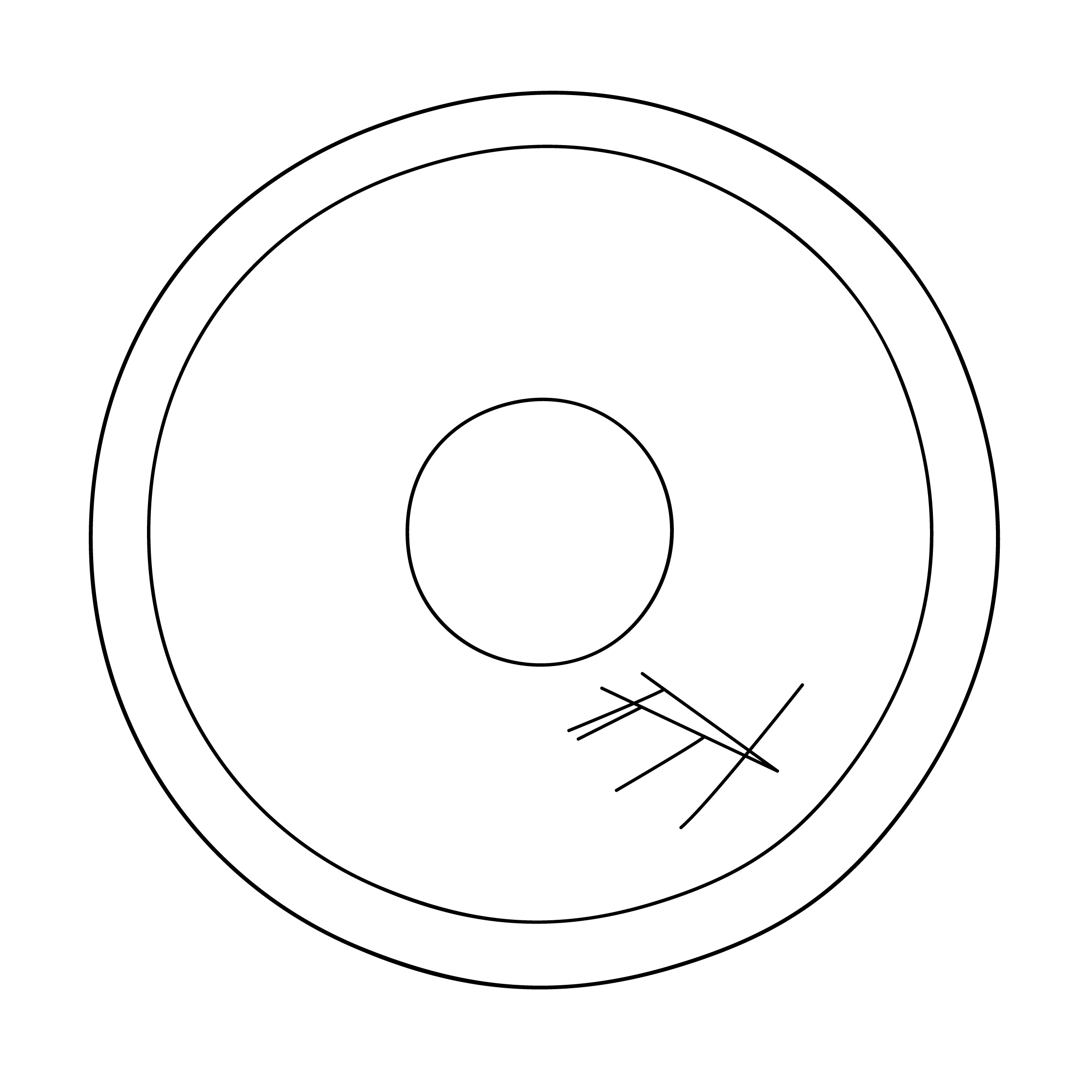
Bibliography
Abbreviation: ARV2J. D. Beazley. Attic Red-Figure Vase-Painters. 2nd ed. Oxford, 1963 605.65; H. R. W. Smith, “Greek Vases,” Art and Archaeology 20 (1925): 121; F. F. Jones and R. Goldberg, Ancient Art in the Art Museum: Princeton University (Princeton, NJ, 1960), 36–37; Abbreviation: Prange, NiobidenmalerPrange, M. 1989. Der Niobidenmaler und seine Werkstatt: Untersuchungen zu einer Vasenwerkstatt frühklassischer Zeit. Frankfurt: Peter Lang., 198, no. N84, pl. 4; Abbreviation: Johnston, Trademarks, AddendaJohnston, A. W. 2006. Trademarks on Greek Vases: Addenda. Oxford: Oxford University Press., 133, no. 36b; Abbreviation: BAPDBeazley Archive Pottery Database. http://www.beazley.ox.ac.uk 207005.
Comparanda
For the Niobid Painter and his workshop, see Abbreviation: ARV2J. D. Beazley. Attic Red-Figure Vase-Painters. 2nd ed. Oxford, 1963 598–612, 1701–2; Abbreviation: ParalipomenaJ. D. Beazley. Paralipomena: Additions to Attic Black-Figure Vase-Painters and to Attic Red-Figure Vase-Painters. Oxford, 1971 394–96; Abbreviation: BAdd2Carpenter, T. H., ed. 1989. Beazley Addenda: Additional References to ABV, ARV2, and Paralipomena. 2nd ed. Oxford: Published for the British Academy by Oxford University Press. 265; T. B. L. Webster, Der Niobidenmaler (Leipzig, 1935); E. Simon, “Polygnotan Painting and the Niobid Painter,” Abbreviation: AJAAmerican Journal of Archaeology 67 (1963): 43–62; E. Harrison, “Preparations for Marathon, the Niobid Painter, and Herodotus,” Abbreviation: ArtBThe Art Bulletin 54 (1972): 390–402; S. Bonomi, “Una nuova pelike del Pittore dei Niobidi,” Abbreviation: AAArchäologischer Anzeiger (1985): 29–47; Abbreviation: Prange, NiobidenmalerPrange, M. 1989. Der Niobidenmaler und seine Werkstatt: Untersuchungen zu einer Vasenwerkstatt frühklassischer Zeit. Frankfurt: Peter Lang.; N. Bonacasa, L’amazzonomachia di Gela del Pittore dei Niobidi (Rome, 1990); Abbreviation: Robertson, Art of Vase-PaintingM. Robertson, The Art of Vase-Painting in Classical Athens. Cambridge, 1992, 18–25; Abbreviation: Matheson, PolygnotosS. B. Matheson. Polygnotos and Vase Painting in Classical Athens. Madison, Wisc., 1995, 9–38; J. Gaunt, “The Niobids on the Niobid Krater in the Louvre: Notes and Conjectures,” in Essays in Honor of Dietrich von Bothmer, eds. A. J. Clark and J. Gaunt (Amsterdam, 2002), 121–26; Abbreviation: Williams, “Workshop View”Williams, D. 2017. “Beyond the Berlin Painter: Toward a Workshop View.” In Padgett, Berlin Painter, 144–88. 158–60. For the figural style of the Princeton vase, in particular the execution of the eyes and ankles, as well as the simple forms used for drapery folds, cf. a kalpis in the New York art market (Antiquarium, Ltd., Ancient Treasures 2, auc. cat. [New York, NY, 2004], no. 9; Abbreviation: BAPDBeazley Archive Pottery Database. http://www.beazley.ox.ac.uk 9032053); a pelike in Germany, Würzburg L 511 (Abbreviation: ARV2J. D. Beazley. Attic Red-Figure Vase-Painters. 2nd ed. Oxford, 1963 604.47; Abbreviation: BAPDBeazley Archive Pottery Database. http://www.beazley.ox.ac.uk 206986); a pelike in England, London E 381 (Abbreviation: ARV2J. D. Beazley. Attic Red-Figure Vase-Painters. 2nd ed. Oxford, 1963 603.45; Abbreviation: Prange, NiobidenmalerPrange, M. 1989. Der Niobidenmaler und seine Werkstatt: Untersuchungen zu einer Vasenwerkstatt frühklassischer Zeit. Frankfurt: Peter Lang., 192, pl. 15, no. N 57; Abbreviation: BAPDBeazley Archive Pottery Database. http://www.beazley.ox.ac.uk 206984). Prange places the Würzburg and London pelikai (supra) and the Princeton kalpis in the Niobid Painter’s “Schlichte” phase (about 470–60 BCE), during which he abandons his earlier, more complicated compositions in favor of simple, two-to-three figure compositions, often scenes of libation. Characteristic of this phase are simple curved nostrils and slightly upturned noses; half-ring ears; peploi with long overfolds, as seen on the woman at the left; and hooked folds of himatia, as seen on that of the man.
For the shape, which is relatively standard within the Niobid Painter’s workshop, see Abbreviation: Prange, NiobidenmalerPrange, M. 1989. Der Niobidenmaler und seine Werkstatt: Untersuchungen zu einer Vasenwerkstatt frühklassischer Zeit. Frankfurt: Peter Lang., 37–38; cf., e.g., Naples STG 199 (Abbreviation: ARV2J. D. Beazley. Attic Red-Figure Vase-Painters. 2nd ed. Oxford, 1963 606.78; Abbreviation: BAPDBeazley Archive Pottery Database. http://www.beazley.ox.ac.uk 207019). For the general development of the hydria in the Early Classical period, see E. Diehl, Die Hydria: Formgeschichte und Verwendung im Kult des Altertums (Mainz, 1964), 49–64. For the patterned groundline and slanted palmettes, cf. Brunswick 1908.3 (Abbreviation: ARV2J. D. Beazley. Attic Red-Figure Vase-Painters. 2nd ed. Oxford, 1963 606.68; Abbreviation: BAPDBeazley Archive Pottery Database. http://www.beazley.ox.ac.uk 207009).
Beazley interpreted this scene as a “king and two women,” and Prange followed suit. There are no definitive attributes that would mark these figures as deities, although the scepter, long hair, and beard of the male figure would fit an identification as Zeus, who offers a libation on two other works by the Niobid Painter: cf. the kalpis in the New York art market (supra); Perugia 846 (Abbreviation: ARV2J. D. Beazley. Attic Red-Figure Vase-Painters. 2nd ed. Oxford, 1963 603.34; Abbreviation: Prange, NiobidenmalerPrange, M. 1989. Der Niobidenmaler und seine Werkstatt: Untersuchungen zu einer Vasenwerkstatt frühklassischer Zeit. Frankfurt: Peter Lang., pl. 25, no. N 44; Abbreviation: BAPDBeazley Archive Pottery Database. http://www.beazley.ox.ac.uk 206972). The subject recurs on a hydria in the painter’s manner: Laon 37.1027 (Abbreviation: ARV2J. D. Beazley. Attic Red-Figure Vase-Painters. 2nd ed. Oxford, 1963 611.37; Abbreviation: BAPDBeazley Archive Pottery Database. http://www.beazley.ox.ac.uk 207084). On all three of these examples, Nike pours the libation into Zeus’s phiale while his female companion wears a crown and holds a scepter, identifying her as Hera. With the man in Princeton we may instead compare other anonymous bearded men by the artist, who also wear wreaths and hold scepters while libating: London E 381 (supra); New York 99.13.2 (Abbreviation: ARV2J. D. Beazley. Attic Red-Figure Vase-Painters. 2nd ed. Oxford, 1963 605.61; Abbreviation: BAPDBeazley Archive Pottery Database. http://www.beazley.ox.ac.uk 207000); Munich SH 2324 (Abbreviation: ARV2J. D. Beazley. Attic Red-Figure Vase-Painters. 2nd ed. Oxford, 1963 604.55; Abbreviation: BAPDBeazley Archive Pottery Database. http://www.beazley.ox.ac.uk 206994). For discussions of libations in the ancient Greek world in general, including the type of liquid used and the context of the libation, ranging from funerary to domestic, see F. Graf, “Milch, Honig und Wein: Zum Verständnis der Libation im griechischen Ritual,” in Perennitas: Studi in onore di Angelo Brelich; Promossi dalla Cattedra di Religioni del mondo classico dell’Università degli Studi di Roma (Rome, 1980), 209–21; E. Simon, “Libation,” in Thesaurus Cultus et Rituum Antiquorum, 3:236–53; F. Lissarrague, “Un ritual de vin: La libation,” in In vino veritas, eds. O. Murray and M. Tecusan (London, 1995), 126–44. For libation scenes on Classical Athenian vases, with a specific focus on the importance of such images for defining social relations between mortals, see M. Gaifman, The Art of Libation in Classical Athens (New Haven, CT, 2018), 51–86. See also, for the significance of the phiale, M. Gaifman, “The Greek Libation Bowl as Embodied Object,” in The Embodied Object in Classical Antiquity, special issue, Art History 41, no. 3, eds. Gaifman, V. Platt, and M. Squire (Oxford, 2018): 444–65.
The graffito on the underside of the foot is most likely a sloppily drawn ΛE in ligature, for which see Abbreviation: Johnston, TrademarksJohnston, A. W. 1979. Trademarks on Greek Vases. Warminster: Aris and Philips., 142–43, 216–17. The type occurs only sporadically in the fifth century, and no other example has been found within the oeuvre of the Niobid Painter.
